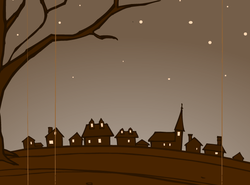This morning, Mathieu P. left the following comment to my post on Melville's poem "Monody":
I am currently reading Melville's Moby Dick. Although I enjoy the book, I fail to understand fully the meaning of the chapter devoted to whaling, such as the one about cetology or the one about whalemen eating whale meat. There are enough comments about religion or cannibals to make me think that these chapter should be taken with a pinch of salt. I do not however understand to which degree exactly they should be taken and what their precise aim is. I would welcome any pointers or explanations. I may add that my only clue about American literature is Leo Marx's The Machine in the Garden, which I read eagerly (my English professor of my undergrad years praised that book).
I thought I'd try to answer publicly, not because I have the answer, but because by coincidence I've been thinking about this very question, among others, for a lecture that I've been invited to give at SUNY Geneseo's English department in honor of the Thoreau scholar Walter Harding. (The lecture is scheduled to take place at 4pm on September 23 on the SUNY Geneseo campus.)
What I hope to talk about at Geneseo is the problem of esoteric knowledge in Melville's work—that is, the sense that the reader has that Melville's work has a secret meaning, and that among the pleasures and duties of reading him is the pursuit of his secret. It isn't at all obvious that a work of art should have a secret meaning, and I think most successful works of art don't. It's hard enough to communicate when one is taking care to be honest and forthcoming. Jane Austen's novels don't seem to have secrets; not even a book as heavy with symbolism as the Great Gatsby does. Infinite Jest, on the other hand, seems to me to be hiding something—to be begging for exegesis—especially toward the end, when it turns compressed and the allusions to Hamlet start to accumulate. Books that provoke in the reader a sense of secret knowledge almost never, of course, make a claim to such knowledge explicitly, so deciding which books fall into the category is tricky and somewhat subjective.
There are more books in the world than anyone has time to read. Why should a reader think it worth his while to ferret out the meaning of a writer who is withholding it? Moreover, why should a reader believe that a withheld meaning is true? When people believe that someone has access to secret truths, it's generally because they think of the person as a prophet, a guru, or even an incarnated god. Why should a novelist have such access? Or to put the question another way: How does a novelist go about convincing readers that he has such access?
This is all a little far afield from Mathieu P.'s particular question, the short answer to which is that there is no consensus about what whaling signifies in Moby-Dick. Two books that suggest answers are Charles Olson's Call Me Ishmael and C. L. R. James's Mariners, Renegades & Castaways, both of which lay more emphasis on political and economic meanings than is common in academic analyses. I hope in my lecture that I will be able to articulate some of my own hunches about the secrets in Moby-Dick, which always sound half-mad even to myself when I try to put them into words. My method will be to compare them to the half-submerged ideas that appear in Mardi and Clarel, two works of Melville's that are less successful but also try to lure the reader into the pursuit of hidden meanings. A whale is an intelligent mammal that doesn't kill, doesn't have to work, and needn't have second thoughts about its sexual nature. Though apparently simple, when that definition works its way through Melville's strangely intertwined ideas about gender, incarnation, sexuality, immortality, and capitalism, the reader ends up in a strange place. I read Byron's Cain this week, and it occurred to me that Melville's whales share a great deal with the beings that existed in the world before Adam, shown to Cain by Lucifer during a visit to Hades:
Cain. What are these mighty phantoms which I see
Floating around me?—They wear not the form
Of the Intelligences I have seen
Round our regretted and unentered Eden;
Nor wear the form of man as I have viewed it
In Adam's and in Abel's, and in mine,
Nor in my sister-bride's, nor in my children's:
And yet they have an aspect, which, though not
Of men nor angels, looks like something, which,
If not the last, rose higher than the first,
Haughty, and high, and beautiful, and full
Of seeming strength, but of inexplicable
Shape; for I never saw such. They bear not
The wing of Seraph, nor the face of man,
Nor form of mightiest brute, nor aught that is
Now breathing; mighty yet and beautiful
As the most beautiful and mighty which
Live, and yet so unlike them, that I scarce
Can call them living.
In Byron's play, the pre-Adamites are not the same as whales, which do however make an appearance a few pages later, when Lucifer, on the same tour of Hades, shows Cain an ocean, a thing Cain has never seen before:
Cain. 'Tis like another world; a liquid sun—
And those inordinate creatures sporting o'er
Its shining surface?Lucifer. Are its inhabitants,
The past Leviathans.


